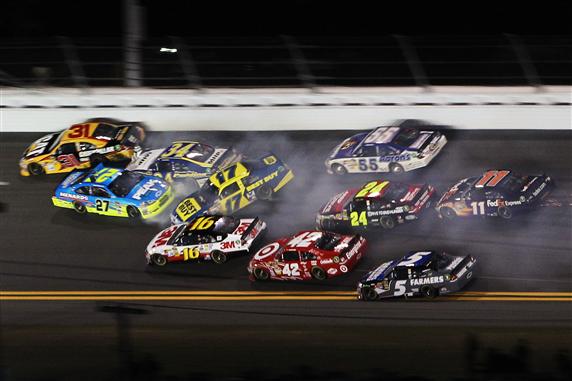
It has been a long three months from the last checkered flag at Homestead to the start of Speedweeks 2012 at Daytona. With how the season ended last year, the anticipation level has been extremely high. For the first time in NASCAR history, two drivers tied for the championship, with victories being the deciding factor.
But no one is talking about the championship battle now as cars rolled into the “World’s Center of Speed.” Instead, it’s all about the package brought to Daytona to tame the tandem draft that ruled the restrictor plate races in 2011.
The tandem draft, or as some have called it the “two-car tango,” had two cars get bumper-to-bumper to gain speed, and virtually never broke up. NASCAR did everything they could to restrict this style of racing, from doing pressure regulations on the cooling system right down to what teams could or could not use to keep the bumpers on the cars sticking together. What this created was a style of racing no one had really seen before, and both fans and drivers had opinions on it.
It was a love-hate necessary relationship, but for the most part, drivers and fans hated the tandem draft because in essence, the driver winning the race was the driver pushing, not the one being pushed.
Knowing this, NASCAR made changes to the aerodynamic package heading into 2012. The tandem draft would not be totally gone, but it would be to the point where it wouldn’t last for multiple laps.
The rule changes include a smaller radiator, a lower pressure setting on the overflow valve, and the vent opening moved higher to the bumper. This was done to not necessarily break up the two-car draft, but to get back to the classic pack racing that the big tracks were known for.
Saturday night was the first taste of the new aero package, and it did work, but also created a problem that is always a risk at the big tracks…the big wreck. Happening one time is a major risk, but in Saturday night’s Budweiser Shootout, it happened on three occasions, and all happened because someone was pushing at the wrong time, and pushed in the wrong spot of the guy in front. This led to many trashed cars, many hurt egos, and many scary moments.
As a follower of the sport for many years, the pack racing is what I remember. The big pack, three-wide and nearly eight or nine deep, is what made NASCAR appeal to many fans because it was that exciting. The big wreck was always a risk because of the style of racing. One mistake has been known to take out half the field, and it could happen at any time in a race. But, sometimes it does provide unexpected moments, like the caution-free races at Talladega in 1997 and 2001. It’s what fans wanted to see, so NASCAR wanted to do what it could to bring it back.
At the same time, the tandem draft does have one advantage…it means that if it comes down to just two drivers for the victory, the slingshot pass will work to perfection, if done at the right time.
Case in point, last Saturday night’s race.
Coming to the white flag, it was Tony Stewart and Kyle Busch going nose-to-tail, pulling away from the field. Busch already had two incidents, or near-incidents, where his car was off the track and back on, so by the time it got to the last lap, the car was bottoming out in the corner with sparks flying below.
Out of turn 4, Busch kept the push on, but coming to the tri-oval he went for it. The run high kept his speed up, but also cut down on the speed that Stewart had. With no pusher, Busch had the run, and all the momentum.
Coming to the checkered flag, the No. 18 just managed to get ahead in time to take the win. Margin of victory, 0.01 seconds.
So maybe the tandem draft does have some use, but for the most part NASCAR’s attempt to regulate it did work. There was some pushing of other drivers to get to the front, but as in every restrictor plate race, when it gets down to the point where it’s either “go or go home,” people get impatient, and push too much.
It resulted in Michael Waltrip and Kevin Harvick catching fire, and Jeff Gordon going for his first official roll in NASCAR. All drivers escaped injury, but this was the risk every driver and fan knew would come when the pack draft made a return to the sport. The advantage now is that with another week until the season-opening Daytona 500, teams can begin to understand how the new drafting style works, and what is needed to make it safer for everyone, thus preventing multiple big wrecks.
It should be interesting as the 54th Daytona 500 goes green next Sunday at 1 p.m. ET on FOX.
ADDITIONAL NOTES:
-Qualifying for the Daytona 500 wrapped up Sunday, with Carl Edwards winning the pole and teammate Greg Biffle starting second. Those two starting positions are guaranteed unless either driver is forced to a backup car. Also, Clint Bowyer’s No. 15 Toyota failed post-qualifying inspection, as it was deemed to be too low on one of the corners. No further penalties are expected other than Bowyer will be forced to start at the rear of his qualifying race.
-The remainder of the field for the Daytona 500 will be set on Thursday in the Gatorade Duel qualifying races.
-Trevor Bayne, Kenny Wallace and Dave Blaney were the fastest of the cars that were not locked into the field based on last year’s owner points. All three had qualifying times fast enough to be guaranteed a starting spot for Sunday’s race.